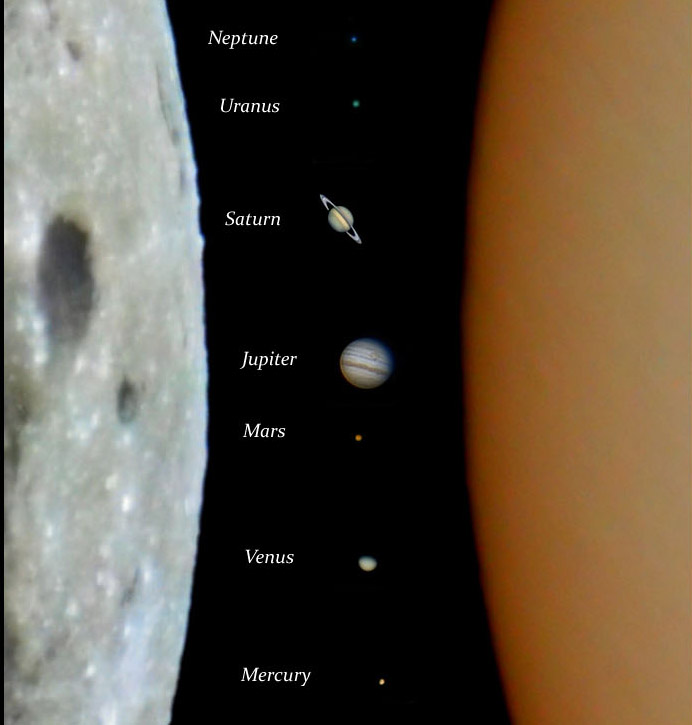Difference between revisions of "April 29, 2011"
| (One intermediate revision by the same user not shown) | |||
| Line 1: | Line 1: | ||
__NOTOC__ | __NOTOC__ | ||
=Sizing Up the Solar System= | =Sizing Up the Solar System= | ||
| + | <!-- Start of content --> | ||
<!-- ws:start:WikiTextHeadingRule:0:<h1> --> | <!-- ws:start:WikiTextHeadingRule:0:<h1> --> | ||
<table class="wiki_table"> | <table class="wiki_table"> | ||
| Line 7: | Line 8: | ||
<em>image by [mailto:tomlinda@bigpond.net.au Tom Harradine], Australia</em><br /> | <em>image by [mailto:tomlinda@bigpond.net.au Tom Harradine], Australia</em><br /> | ||
</td> | </td> | ||
| − | <td>When I give talks I commonly state that the Moon is the most fascinating object in the sky. The reason is that it appears quite large to us and it has a complex surface with constantly changing lighting. Tom has now provided a great graphic demonstrating how puny and feature-poor the rest of the solar system is. Using photos he has taken all at the same scale he compares the relative sizes of the Sun, Moon and planets. Notice that the biggest - Jupiter and ringed Saturn - are about the same angular size as the mare patch on the floor of [ | + | <td>When I give talks I commonly state that the Moon is the most fascinating object in the sky. The reason is that it appears quite large to us and it has a complex surface with constantly changing lighting. Tom has now provided a great graphic demonstrating how puny and feature-poor the rest of the solar system is. Using photos he has taken all at the same scale he compares the relative sizes of the Sun, Moon and planets. Notice that the biggest - Jupiter and ringed Saturn - are about the same angular size as the mare patch on the floor of [https://the-moon.us/wiki/Riccioli Riccioli.] Any size optical instrument, from eyeballs to the Hubble Space Telescope, will show more details when pointed at the Moon than at any other solar system target. I am not saying don't observe the lesser bodies in the solar system, but if you consider observing an investment of your time, the payoff is greatest for the Moon.<br /> |
<br /> | <br /> | ||
<em>[mailto:tychocrater@yahoo.com Chuck Wood]</em><br /> | <em>[mailto:tychocrater@yahoo.com Chuck Wood]</em><br /> | ||
| Line 20: | Line 21: | ||
<p><b>Tomorrow's LPOD:</b> [[April 30, 2011|Miracle Material]] </p> | <p><b>Tomorrow's LPOD:</b> [[April 30, 2011|Miracle Material]] </p> | ||
<hr /> | <hr /> | ||
| + | {{wiki/ArticleFooter}} | ||
Latest revision as of 18:02, 18 August 2018
Sizing Up the Solar System
 image by Tom Harradine, Australia |
When I give talks I commonly state that the Moon is the most fascinating object in the sky. The reason is that it appears quite large to us and it has a complex surface with constantly changing lighting. Tom has now provided a great graphic demonstrating how puny and feature-poor the rest of the solar system is. Using photos he has taken all at the same scale he compares the relative sizes of the Sun, Moon and planets. Notice that the biggest - Jupiter and ringed Saturn - are about the same angular size as the mare patch on the floor of Riccioli. Any size optical instrument, from eyeballs to the Hubble Space Telescope, will show more details when pointed at the Moon than at any other solar system target. I am not saying don't observe the lesser bodies in the solar system, but if you consider observing an investment of your time, the payoff is greatest for the Moon.
|
Yesterday's LPOD: Out the Porthole View
Tomorrow's LPOD: Miracle Material
COMMENTS?
Register, Log in, and join in the comments.



